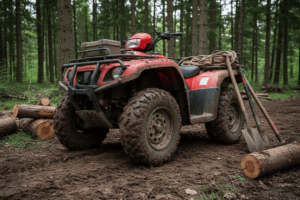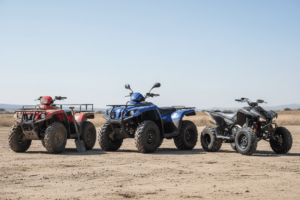ATV, quad, and 4-wheeler have different meanings, although they are often used interchangeably. ATV means all-terrain vehicle, which is a general term under which come other types of off-road vehicles. A quad is a specific term that refers to a 4-wheeled ATV. Generally, riders would refer to their quads simply as “four-wheelers”.
Understanding the difference between these not only allows riders to choose the right fit for keeping smooth rides on the rugged trails according to power, stability, or safety, but it also better informs the differences to know which type is and how it differs from others. This guide outlines each type and compares their differences with respect to off-road riding.
Table of Contents
ToggleSome Basic Understandings Of ATV, Quads, And 4-Wheelers
Understanding the basics of ATVs, quads, and four-wheelers sets the foundation for choosing the right ride. Though often confused, each serves a unique role in off-roading, differing in design, performance, and intended terrain.
What is ATV?
ATV refers to all-terrain vehicles. ATVs are vehicles built to go where even ordinary vehicles lose their usefulness. They are built onto a heavy-duty suspension, with wide tires that use handlebars instead of steering wheels to draw direct control into the desired direction.
However, the word ATV generally means any vehicle that can do almost anything. It is also used for machines controlled by what are popularly termed ATV control sets, which combine power and stability on rugged and slippery surfaces.

What Does Quad Mean?
Quad is short for quadricycle. It is sometimes used to refer to the lighter, faster versions of an ATV, which are most commonly applied in races and sport riding. These models are designed with enhanced vehicle dynamics, making them lighter and faster than regular ATVs.
So, quad vehicles generally refer to all sport models produced for performance, be it for use on tracks, sand dunes, or through the competitive course.

What Does A 4 Wheeler Mean?
4 Wheeler is a very broad informal term, one that usually means any off-road quads. This term can classify all kinds of ATVs, quads, or even larger side-by-sides.
In fact, 4-wheeler means every kind of ATV; only a few know the difference. Understanding this will be a big hassle right at the point of shopping or in debates over all kinds of off-road vehicles.
Major Differences between ATV, Quad, and 4 Wheeler
While ATVs, quads, and four-wheelers may appear similar, their design, purpose, and functionality set them apart. The key differences lie in their handling, power output, terrain adaptability, and whether they’re meant for utility, sport, or recreation.
Design and Structure
The main difference actually resides in the way of construction. An ATV is famous for its most versatile capacity. They have very strong frames, wider stances, and large, deep-tread tires for grip while going over rough ground.
But, on the whole, quads appear to be lighter, faster-moving units, geared towards performance instead of heavy-duty work. The sportier body styles, tighter suspension systems for control while jumping or taking sharp turns, make them distinguishable from the 4-wheelers.
4-wheelers could look like any of these types, from the most utility 4-wheelers to those made purely for recreation. The name itself says everything that has four off-road tires.
Licensing and Legal Categories
The laws concerning these vehicles are generally the same. Most say that an ATV is street-legal. But a quad is an all-terrain vehicle that can only be trailered or used on private property or state-designated areas.
Some require a minimum registration, safety gear, and rider age limits. Those utility 4-wheelers, which are classified as farm vehicles, probably have special permits or vehicle classifications. Checking on local laws before heading out onto the trails is always a good idea to avoid fines or restrictions.
Quick Comparison Table: ATV Vs 4 Wheeler Vs Quads
| Type | Focus | Typical Use | Ideal Rider |
|---|---|---|---|
| ATV | Versatility | Work and adventure | Farmers, explorers |
| Quad | Speed & sport | Racing and recreation | Performance riders |
| 4-Wheeler | General category | All uses | Casual riders |
Types of ATVs and Their Uses
There are many kinds of ATVs. Choosing one type or another depends on work, sport, or pure fun. Below are the major classifications.
Utility ATVs
Utility ATVs have been built for muscle and power. They are usually found on farms, construction sites, and, at times, deep in the forests.
These models have stronger frames for freight racks and engines built with maximum torque rather than maximum speed. Most will carry one or more winches and tow hitches, making them perfectly suitable for heavy-duty work.
Sports or Quad ATVs
Such types of quads are designed for those thrill-seekers who require speed and power with a perfect power-to-weight ratio. The sport ATVs are lightweight and fast, and precision-built for dirt tracks or dunes.
Sport models will usually feature advanced suspension systems for high jumps and precise cornering. If you are into racing or insane trail riding, you have to invest in something that suits you quite well.
Youth and Recreational ATVs
Youth ATVs are smaller, weigh less, and are designed with user safety as a priority. They are perfect for first-timers, families with toddlers, or young riders just beginning to control their vehicles.
For such types of ATVs, manufacturers intentionally limit engine sizes and speeds to ensure maximum control, and some even set up a parental control block or remote shut-off system. They are just right for family hangouts over a nice weekend or to help introduce the younger generation to off-road riding.
Comparison Table for Types of ATVs and Their Uses
| Type of ATV | Main Features | Typical Use / Ideal Rider |
|---|---|---|
| Utility ATVs | Strong frames, high torque engines, racks, and towing capacity | Work, farming, construction, and heavy-duty tasks |
| Sports / Quad ATVs | Lightweight, fast, precise suspension, built for performance | Racing, high-speed trail riding, thrill-seekers |
| Youth & Recreational ATVs | Small size, low weight, safety-focused, limited engine power | Beginners, families, and young riders learning control |
Performance Comparison
When it comes to performance, ATVs, quads, and four-wheelers each deliver distinct capabilities. ATVs offer versatile handling across rough terrain, quads emphasize agility and speed for sport riding, while four-wheelers focus on stability, control, and power for heavier utility tasks.
Engine Sizes and Power
ATVs and quads differ significantly in engine size range, which stretches from around 90 cc to 700 cc. Smaller engines are suited for the beginner or the young rider, while those big machines are the real deal with full torque for those hard trails or races.
Two things to note:
- Low cc models (90 – 250cc) are much easier to handle, thus suited for the beginner.
- High cc ones (400 – 700cc) are designed for the expert rider who requires the power.
The power of the engine is the first concern when buying an ATV; a little guide here is set to help you:
- 90cc–125cc- For kids, teens, and complete beginners alike. Very light engines, simple to control, and let you learn safely.
- 150cc–250cc- Suitable for more relaxed adult riders or anyone using ATVs for lighter tasks. They form a bridge between fun performance and manageable power.
- 300cc–450cc- Good for intermediate riders needing more action in the acceleration department and dealing with tougher terrain or moderate loads.
- 500cc–700cc- More for protection, heavy-duty work, and professional riders. These vehicles offer maximum torque and speed for hauling purposes, steep trails, or racing.
The smaller-displacement bikes in the sub-250cc range are easier to manage and thus recommended for beginners, while bikes between 400-700cc will have the muscle for experienced riders. Always choose the engine according to your skill, comfort, and use; bigger is not always better.
Handling and Suspension
Handling defines how your ride feels. Utility ATVs have soft suspensions that absorb shocks from bumpy ground.
Contrary to that, the sport quad handling is a hard one for fast response and sharp turns. A sport quad gives the rider better control during jumps and races.
Terrain Capability
Every ATV or quad excels in specific terrains. Knowing which ones in your area suit your vehicle will greatly improve your riding experience. The strong utility ATVs have no fear of muddy and snowy rocky trails- that is where traction and torque come into play. They have heavy frames with deep-tread tires, and move at low gears to grip an unsteady surface and pull easily through any slippery or rough terrain.
Sport quads are opposite. They are made for dry open terrain; they are best in sand dunes, dirt tracks, and deserts. Their lightweight frames and responsive suspensions help them to turn, jump, and floor it on a flat or hard surface.
If mixed conditions are the order of the day, such as trails switching from dirt to gravel or grassy hills, then a middleweight quad provides the most comfort by striking the best performance balance. Its handling across different terrains, within limits, is roadworthy.
Ultimately, matching your ATV or quad to the terrains you ride most often ensures smooth handling, better control, and fewer breakdowns. This will increase your confidence in pursuing any pathway with safety and ease through mechanical stability principles.
Choosing the Right One for You
Being a first-time off-road vehicle buyer is a difficult experience. However, if you focus on purely fulfilling a purpose, then there remains a clear path.
Purpose Identification
The first will be to come and ask yourself, “What do I need it for?”
If it’s working, land management, load hauling, or snow plowing, then a utility ATV or four-wheeler is the best fit for you. They place strength and endurance above all else. Going with a sport quad automatically makes that decision good with speed and wild fun.
Terrain and Skill Level
Your setting and experience come into play. A beginner should start small regarding ATVs that offer stability and predictability for skills training and development.
For rough terrains, think about deep-tread tires and adjustable suspension for those kinds of models. Also, sport quads might allow more maneuverability on smoother tracks or racing circuits. It is about comfort and control, not just speed.
Budget Along With Maintenance Tips
When buying an ATV or quad, consider it an investment. Besides the buying price, also factor in fuel prices, tire prices, and maintenance. Cleaning, oil changes, and inspections made regularly are part of basic maintenance.
Choose brands that offer spare parts, and consider service that is affordable. Clean your ride after every trip to avoid dirt build-up, which will eventually cause damage. A little attention goes a long way towards ensuring long-term good performance.
BSEMotors: Engineering for Every Rider
BSEMotors, a prominent off-road brand, takes pride in establishing machines that are durable and highly powerful for every rider. Catering to a broad spectrum, including utility ATVs, sports quads, and sleek and agile sports, the company is mindful of the fact that the powertrain of every model has to undergo stringency testing before being streamlined into balance, stability, and controllability.
One of the best options available for riders keen on power is 150cc, 250cc, 300cc, and 450cc engines. BSEMotors pursues performance and comfort alongside strength, frames, suspension, improved handling, and smooth ergonomics. In the eyes of the off-road critics, the company is trustworthy for its excellent quality output.
FAQs
ATV or four-wheeler; which one is safer for newbies?
A beginner should use a four-wheeler or a very low-cc ATV because the four-wheeled design will provide much more stability and balance, but do remember to gear up and stay within your ability.
How fast does an ATV go?
Speed depends on how big the engine is. Small units might reach a maximum speed of about 40km/h, while much bigger, high-performance racing units barrel beyond 120 km/h. Speed should still depend on the terrain and mostly on the rider’s experience.
Do you need the License to Ride One ATV or Quad?
In some countries, they demand proof of registration or a permit, but in other countries, there are no licensing rules. Also, verify the state laws before using them.
Best Terrain To Ride an ATV?
ATVs suck up trails, bog through mud, climb hills, and race on sand. Utility models are best in gnarly wet stuff; sport quads shine as speed kings on the dry, wide-open track.
Conclusion
Now you know the difference between a quad versus an ATV or 4-wheeler, which means you can have a much easier choice. Whereas an ATV can offer total versatility, a quad is made just for performance and thrills; on the other hand, a 4-wheeler covers almost anything from work to leisure activities.
And when you have learned what best fits each type, then it can be matched to intended use, terrain, and skill level for off-road recreation at its best in the future.
And for those wanting all in one ring: reliability, power, and affordability, then look no further because BSEMotors just fit the bill: machines meant to be devoted to every rider and every adventure.

